Vizslas Dog
- February 1, 2024
- 0 comment
Vizslas, often affectionately referred to as “Velcro dogs,” are a charming and affectionate breed that hails from Hungary. These medium-sized dogs are known for their striking appearance, with a sleek and elegant rust-colored coat and expressive eyes. But it’s not just their looks that make Vizslas so beloved; it’s their friendly and loyal nature that truly sets them apart. They are often considered part of the family, forming strong bonds with their owners and earning their reputation as excellent family pets.
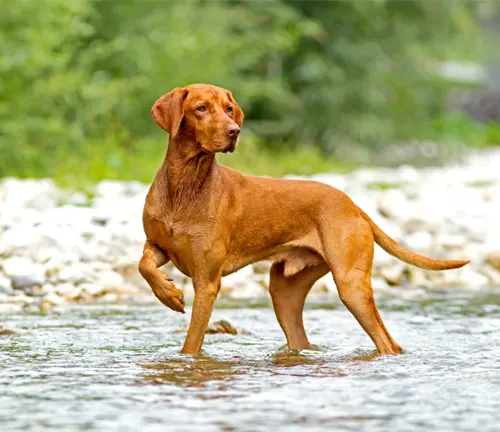
Vizslas are highly intelligent and trainable, which makes them versatile companions for various activities, including hunting, agility, and obedience competitions. Their energy levels are boundless, so they thrive in active households that can provide them with the exercise and mental stimulation they need. Despite their active nature, Vizslas are also known for their gentle and patient demeanor, making them great with children and other pets.
In terms of grooming, Vizslas have short coats that are relatively low-maintenance, shedding minimally. Their health is generally robust, but like all breeds, they can have certain predispositions to specific health issues. To ensure their well-being, regular exercise, proper nutrition, and routine veterinary care are essential.
| Specification | Description |
|---|---|
| Breed Name | Vizslas (Hungarian Vizsla) |
| Size | Medium-sized |
| Coat Color | Rust-colored with a short, sleek coat |
| Temperament | Affectionate, friendly, and loyal |
| Energy Level | High energy, requiring daily exercise |
| Intelligence | Highly intelligent and trainable |
| Compatibility | Excellent family dogs and good with kids |
| Grooming Needs | Low maintenance, minimal shedding |
| Common Health Issues | Potential for hip dysplasia and allergies |
| Lifespan | Typically 10-14 years |
| Origin | Hungary |
| Use | Originally bred for hunting, now popular as companions and show dogs |
A Guide to this Beloved Breed

Vizslas, often referred to as “Velcro dogs” for their affectionate nature, are a beloved breed known for their unique characteristics and charming personality. In this article, we will dive deep into the world of Vizslas, exploring their history, characteristics, care requirements, and much more. So, if you’re considering bringing a Vizsla into your life or simply want to learn more about this wonderful breed, read on!
History of Vizslas
The origins of the Vizsla can be traced back to Hungary, where they were bred for hunting and companionship. This section will explore the rich history of Vizslas and their evolution from hunting dogs to beloved family pets.
The Early Origins:
The Vizsla’s history dates back to at least the 9th century in Hungary, making them one of the oldest known hunting breeds in Europe. Hungarian nobility greatly valued their hunting abilities, and Vizslas were highly prized for their skill in tracking and retrieving game. These dogs were initially used to hunt birds, particularly falcons, making them known as “falconer’s dogs.“
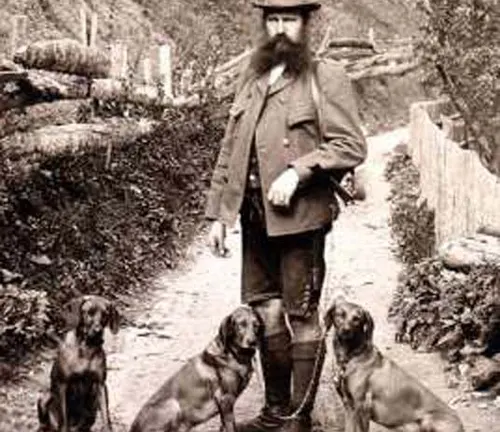
Modern Transition
In the 20th century, Vizslas began their transition from hunting dogs to versatile companions. Breeders focused on preserving the breed’s hunting instincts while making them suitable for family life. This transition has made Vizslas popular not only as hunting partners but also as loving family pets and show dogs.
Physical Characteristics
Vizslas possess distinct physical features that set them apart. This section will explore their appearance, size, coat, and other notable characteristics.



- Sleek and Elegant Build: Vizslas have a well-balanced and athletic appearance. They are medium-sized dogs with a lean and muscular build. Their physique reflects their agility and stamina, making them excellent hunters.
- Rust-Colored Coat: One of the most defining features of Vizslas is their short, smooth, and shiny rust-colored coat. This reddish-brown coat gives them a regal and elegant look. The coat is easy to care for and minimally sheds.
- Expressive Eyes: Vizslas are known for their soulful and expressive eyes. They have large, almond-shaped eyes that are typically a shade of brown or amber. Their eyes are a window to their friendly and affectionate nature.
- Long Ears: Vizslas have long and slightly pendulous ears that hang close to their head. These ears add to their charming appearance and enhance their sense of hearing, which is valuable during hunting.
- Docked Tail: Traditionally, Vizsla puppies had their tails docked, leaving them with a short tail. However, tail docking practices have become less common in recent years, and some Vizslas now have naturally long tails.
- Paws and Feet: Vizslas have compact and well-arched toes with thick paw pads, making them surefooted and ideal for traversing various terrains, whether in the field or during play.
- Overall Graceful Appearance: The combination of their sleek coat, expressive eyes, and graceful physique gives Vizslas an overall appearance of elegance and poise. Their beauty is often celebrated in the show ring.
Temperament and Personality
One of the most endearing qualities of Vizslas is their affectionate and friendly disposition. In this section, we’ll explore their temperament, loyalty, and compatibility as family pets.

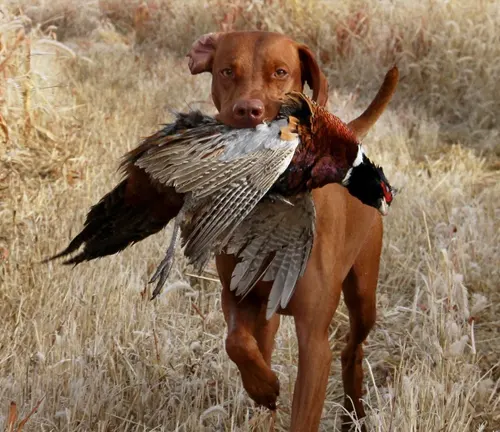

- Affectionate and Loving: Vizslas are known for their deep affection and strong bond with their human family members. They are often referred to as “velcro dogs” because they have a tendency to stick close to their owners, seeking constant companionship and affection. This loving nature makes them wonderful family pets.
- Friendly and Social: These dogs are typically outgoing and friendly, both with their human family and with strangers. They are rarely aggressive and tend to greet new people with enthusiasm. This social nature makes them well-suited for households with guests and children.
- Loyal and Devoted: Vizslas are incredibly loyal to their owners. They form strong attachments and are known to be protective when they sense any potential threats. This loyalty extends to their role as watchdogs, as they will bark to alert their owners to any unusual activity.
- Intelligent and Trainable: Vizslas are highly intelligent dogs, which makes them quick learners. They thrive on mental stimulation and enjoy tasks that challenge their intellect. This trait, combined with their eagerness to please, makes them highly trainable in obedience and various dog sports.
- Energetic and Playful: One of the defining characteristics of Vizslas is their boundless energy. They are enthusiastic and playful, often engaging in lively games and activities. Daily exercise is essential to keep them physically and mentally satisfied.
- Good with Children and Other Pets: Vizslas are generally excellent with children, making them suitable family pets. They are patient and gentle, and their playful nature makes them wonderful playmates for kids. With proper socialization, they can also get along well with other pets in the household.
- Curious and Adventurous: These dogs have a curious and adventurous spirit. They love exploring their surroundings and are always up for an outdoor adventure. Whether it’s hiking, running, or playing fetch, Vizslas are enthusiastic companions.
Training and Exercise Needs
Vizslas are intelligent and active dogs, which comes with specific training and exercise requirements. This section will provide guidance on how to keep your Vizsla happy and well-behaved.
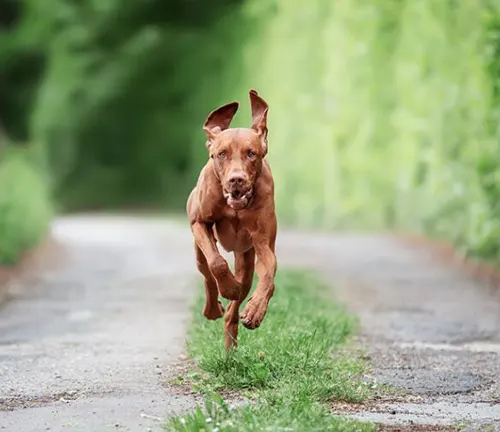
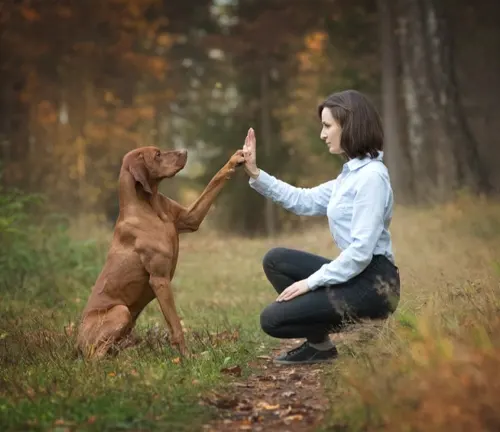
- Daily Exercise Requirement: Vizslas are a high-energy breed that thrives on physical activity. They require at least one to two hours of exercise every day to keep them happy and healthy. Daily exercise not only helps them burn off excess energy but also keeps them mentally stimulated.
- Mental Stimulation: In addition to physical exercise, Vizslas need mental stimulation to prevent boredom and potential destructive behavior. Engaging them in activities like puzzle toys, interactive games, and obedience training can help keep their sharp minds engaged.
- Obedience Training: Vizslas are highly intelligent and eager to please, making them receptive to obedience training. Consistent, positive reinforcement-based training is essential to ensure they develop good behavior and respond well to commands. Early socialization is also crucial to help them become well-rounded and well-behaved dogs.
- Agility and Dog Sports: Many Vizslas excel in agility and various dog sports due to their athleticism and intelligence. Engaging them in agility courses, flyball, or even competitive obedience can be an excellent way to channel their energy and stimulate their minds.
- Variety in Exercise: Vizslas enjoy a variety of physical activities. This breed loves running, playing fetch, swimming, and hiking. Providing a mix of exercises can help prevent boredom and satisfy their need for adventure. Off-leash play in a secure, fenced area can also be a great way for them to burn off energy.
Health and Care
Maintaining the health and well-being of your Vizsla is crucial. This section will cover common health issues, grooming tips, and dietary recommendations.
Regular Veterinary Care
Schedule regular check-ups with your veterinarian to monitor your Vizsla’s overall health. Routine vaccinations, parasite control, and dental care are essential components of preventive healthcare.
Common Health Concerns
While Vizslas are generally healthy dogs, they can be prone to certain health issues. Keep an eye out for conditions such as hip dysplasia, elbow dysplasia, skin allergies, and eye problems. Early detection and prompt veterinary intervention are crucial.

Proper Nutrition
Provide your Vizsla with a well-balanced and high-quality dog food that meets their specific nutritional needs. Consult with your veterinarian to determine the best diet plan, including portion control to maintain a healthy weight.
Grooming and Coat Care
Vizslas have short, smooth coats that require minimal grooming. Brushing them occasionally can help reduce shedding and keep their coat looking its best. Bathing should be done as needed, but not excessively, to avoid drying out their skin.
Exercise and Mental Stimulation
As mentioned earlier, Vizslas are highly active dogs that require both physical and mental stimulation. Regular exercise and engaging activities are essential to keep them happy and prevent boredom-related behaviors.
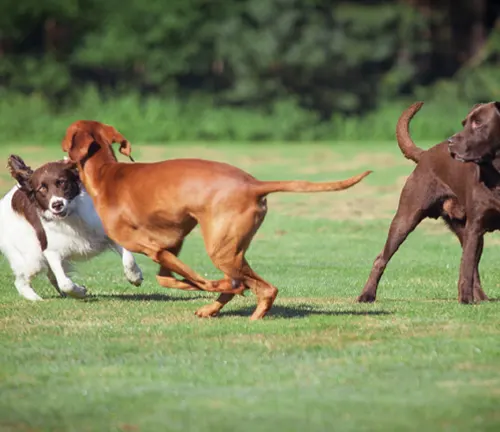
Socialization
Early socialization is crucial to ensure that your Vizsla is well-adjusted and comfortable around other dogs and people. Exposure to different environments, experiences, and people during their puppyhood can help them become well-rounded adults.
Preventive Measures
Protect your Vizsla from parasites such as fleas, ticks, and heartworms through appropriate preventive measures prescribed by your veterinarian. Regularly inspect their ears, teeth, and paws for any signs of issues.
Spaying/Neutering
Discuss with your veterinarian whether spaying or neutering is appropriate for your Vizsla. This decision may depend on factors like age, gender, and intended use of your dog.
Environmental Safety
Ensure a safe environment for your Vizsla by securing toxic substances, removing hazards, and providing a secure, fenced area for outdoor activities.
Love and Attention
Vizslas thrive on human companionship and love to be part of the family. Spend quality time with your dog, provide affection, and create a loving bond that contributes to their overall well-being.
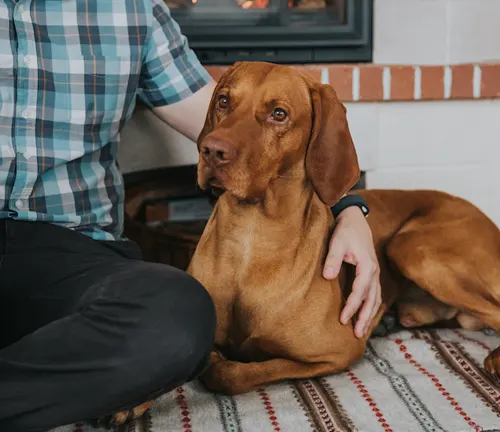
Different Species
The term “Vizsla” typically refers to a specific breed of dog, the Hungarian Vizsla. There are no different species of Vizslas. However, within the Vizsla breed, there can be variations in terms of coat color and markings, but these do not constitute different species.

Frequently Asked Questions (FAQs)
1. Are Vizslas good with other pets?
Vizslas can get along well with other pets if properly socialized from a young age. They tend to have a friendly disposition towards other animals.
2. How much exercise do Vizslas need daily?
Vizslas require at least an hour of exercise each day to stay happy and healthy. Regular physical activity is essential to their well-being.
3. Do Vizslas shed a lot?
Vizslas have a short coat that sheds minimally, making them a good choice for individuals with allergies or those who prefer a clean home.
4. Are Vizslas easy to train?
Yes, Vizslas are known for their intelligence and trainability. With consistent and positive reinforcement-based training, they can excel in obedience and various activities.
5. Do Vizslas make good watchdogs?
While Vizslas are alert and will bark to alert their owners, they are generally too friendly to be considered guard dogs. They may not be suitable for guarding duties.
6. What is the average lifespan of a Vizsla?
Vizslas typically have a lifespan of 10 to 14 years, depending on their overall health and care.
7. Do Vizslas require a lot of grooming?
Vizslas have a short coat that is low-maintenance. Occasional brushing and basic grooming are usually sufficient.
8. Are Vizslas good for first-time dog owners?
Vizslas can be suitable for first-time dog owners who are committed to providing the necessary exercise and training.
9. Do Vizslas suffer from separation anxiety?
Vizslas are known for their attachment to their owners, and they can experience separation anxiety if left alone for extended periods. Proper training and gradual introductions to being alone can help alleviate this.
10. Are Vizslas good with children?
Yes, Vizslas are generally good with children and are known for their gentle and patient nature. However, supervision is always recommended when dogs and young children interact.
11. What is the origin of the Vizsla breed?
Vizslas originated in Hungary and were historically used as hunting dogs for Hungarian nobility.
12. Do Vizslas require a fenced yard?
While a fenced yard is not an absolute necessity, it is highly recommended for Vizslas, as they are active and enjoy outdoor play.
13. Are Vizslas prone to specific health issues?
Vizslas can be prone to certain health issues, including hip dysplasia, eye problems, and skin allergies. Regular veterinary check-ups can help monitor their health.
14. Can Vizslas adapt to apartment living?
Vizslas can adapt to apartment living if they receive sufficient exercise and mental stimulation. However, they do best in homes with access to outdoor space.
15. Are Vizslas good swimmers?
Vizslas are natural swimmers and often enjoy water activities. Their webbed feet and strong bodies make them proficient swimmers.
16. Do Vizslas require a lot of socialization?
Socialization is important for Vizslas to ensure they are well-adjusted and comfortable around people and other dogs.


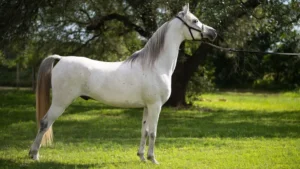



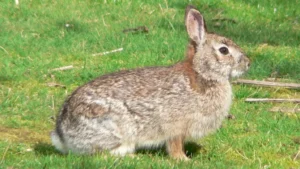







Leave your comment